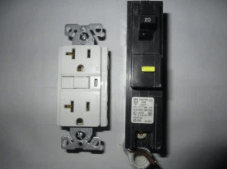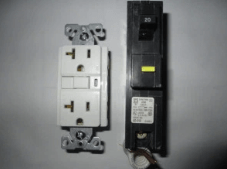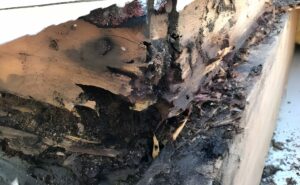
A $20 Ground Fault Circuit Interrupter (GFCI – GFI) could save your life, Don’t put it off any longer – October 27, 2014
Missing GFCI – GFI outlets and breakers are one of the most often listed defects found by home inspectors, building code officers, and city occupancy officials.
Where should you install GFI outlets? GFCIs are required by the National Electrical Code (NEC) in kitchens, bathrooms. crawl

spaces, unfinished basements, garages, hot tubs, swimming pools outbuildings, sump pumps dishwashers, within 6 feet of sinks, and outdoor receptacles. These are just a few of the areas requiring GFCI – GFI protection.
Owners of older houses can retrofit $20 GFCI – GFI outlets at those locations or have GFCI – GFI breakers (about $50) mounted in the main breaker panel. Portable GFI adapters, which plug into regular wall receptacles, are available for $20 to $40.
Installing a GFCI could save your life
GFCI protection could prevent as many as two hundred deaths by electrocution every year as well as countless unnecessary burns and fires. The GFCI circuit was first invented in 1961 and has been slowly incorporated into the NEC. GFCI protection for receptacles has been required by the NEC since:
- 1971 Swimming Pools & Exterior Receptacles
- 1975 Bathrooms
- 1978 Garages
- 1981 Spas & Hot Tubs
- 1987 Kitchens, Hydro Tubs, Unfinished Basements, and Boat Houses
- 1990 Crawl spaces * (it is advisable to install the GFCI receptacle for crawl spaces at the crawl space entry point when possible)
- 1993 All Sinks, Tubs, and Showers (with-in 6′)
- 2005 Laundry and utility sinks (with-in 6′)
- 2014 GFCI & AFCI required in kitchen and laundry areas
- 2014 Dishwashers *
- 2017 Garage Door Operators *
- 2017 Decks, Balconies, and Porches
*GFCI must be readily accessible: if you have to move objects or use a ladder to reach the GFCI it is not considered readily accessible.)
GFCI – GFI are Required for Wet surfaces
We recommend GFCI – GFI protection in any area that is within six feet of a water source or over wet surfaces. Metal sinks should be included in this measurement. Wet surfaces include surfaces that may become wet and provide an open-source to ground such as a wet garage or basement floor.
Finished basements with carpet are usually exempted. GFCI- GFI protection for outdoor receptacles is required regardless of the floor type.
Please do not confuse fuses and standard circuit breakers with GFCIs. Fuses and standard circuit breakers work on the principle of failing when more current flows through a circuit than it was designed to carry.
A typical house circuit is a number 12 wire protected by a 20 amp fuse or breaker. Which will melt (trip for breakers) before the wire overheats and causes a fire hazard.
Unfortunately, a very small amount of current can kill a person who is in contact with a source of grounding. Such as the kitchen faucet or wet concrete without tripping a breaker or blowing a fuse.
GFCIs trip at a 5 milliamp current leak
A GFCI receptacle or GFCI circuit breaker monitors the flow of electricity between the hot and neutral wires 30 to 40 times per second and will trip (disconnect) the circuit when a difference of as little as .05 amps is detected. (that’s not enough to power a flashlight).
Some GFCIs will continue to operate even after the electronic switch that shuts them off has failed. Therefore GFCI receptacles and breakers should be tested monthly and replaced if defective.
The third wire (ground wire) found on many tools and appliances is only effective for larger current leaks and is not sufficient protection for use in wet areas. Many handheld appliances such as hair dryers and curling irons that are typically used around water sources have GFCI protection built into the power cord.
The third wire on your small appliance or power tool is the ground wire. The ground wire is there to provide a low impedance path to ground, preventing the equipment user from becoming the ground path.
Thus providing protection to the user from electrical shock. The ground wire is typically connected to the outer case of your tool or appliance so if a current leak occurs it will trip the GFCI.
Older homes should be updated
Circuits installed before the late 60’s probably do not have the protection of a grounding circuit. The NEC allows GFCIs to be used to upgrade older two-prong (non-grounded) outlets to three-prong (grounded) outlets without installing any new wire.
The use of two-prong to three-prong adapters and replacing two-prong with three-prong non grounded receptacles is not encouraged without GFCI protection.
When the GFCI is installed in a two-wire circuit it must have a label that says “No Equipment Ground” on the GFCI outlet and all downstream outlets. Please note most GFCI testers will not trip the GFCI if a ground wire is not present
You may want to install a grounded circuit for your sensitive electronic products. Many electronic products such as computers and TVs use the ground wire as a means of dissipating static electricity.
Parts of this article came from the following sources;
http://www.cpsc.gov//PageFiles/118853/099.pdf
http://www.osha.gov/SLTC/etools/construction/electrical_incidents/gfci.html
http://www.simple.wikipedia.org/wiki/GFC
http://www.esgroundingsolutions.com/blog
For information about our warranties
Warranty
Check us out at the Better Business Bureau




